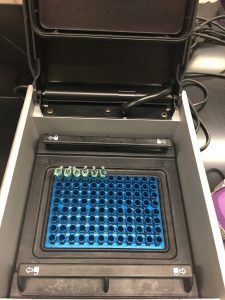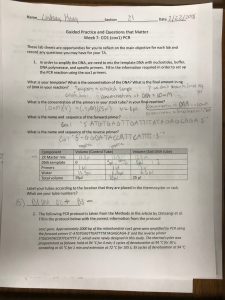Lab 13 Gel Electrophoresis 3
Lab 13 Gel Electrophoresis and Poster Design 4/12/2018
Purpose
The purpose of this week’s lab was to do our final gel electrophoresis with the Chelex protocol DNA and start designing our poster for the final presentation.
Process
First, we took our DNA, which was premixed with the dyes, and loaded 10 micro-liters of each control and the eDNA into the gel. Because we are only using the V4 primer this time, we shared a gel box with group six. Since we shared a gel with group six, we only used one 5 microliter ladder. Next the gel was run at 100v for 30+ minutes. While these were running, we looked at what would happen to our eDNA if it yielded positive results. Our group then worked on the QTM which included writing 2-3 sentences per section to use in our abstract and choosing a poster design. Our group decided to go with a simple blue poster that, hopefully, we can include things like a flow chart in. We then took our gel upstairs to view it through the Bio-rad imaging machine. There is some sort of problem with our DNA because the eDNA showed bands but the positive control did not show a similar band. Because of this, we should test our DNA over again to see where the problem lies.
(In order Ladder, (G5) negative, positive, eDNA, (g6) negative, positive, eDNA)
Conclusion
Because there is some sort of mistake with our positive DNA, the next logical step would be to retest it and see where the mistake is. But, this might not happen just because the semester is coming to a close. We stored our DNA back in the rack used when they went to the Thermocycler in the top row, spots 4,5,and 6. Before next week, we hope to have the abstract, introduction, methods and materials, and results section done of our poster. Kaitlyn will be working on the abstract, I will work on the introduction, sandi will work on the results, and we all will look over the materials and methods since there is so much to cover.















